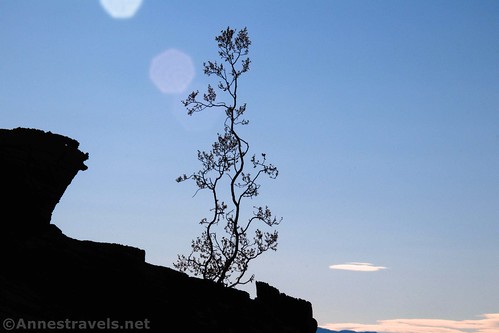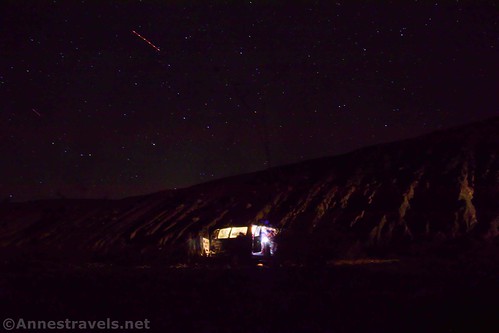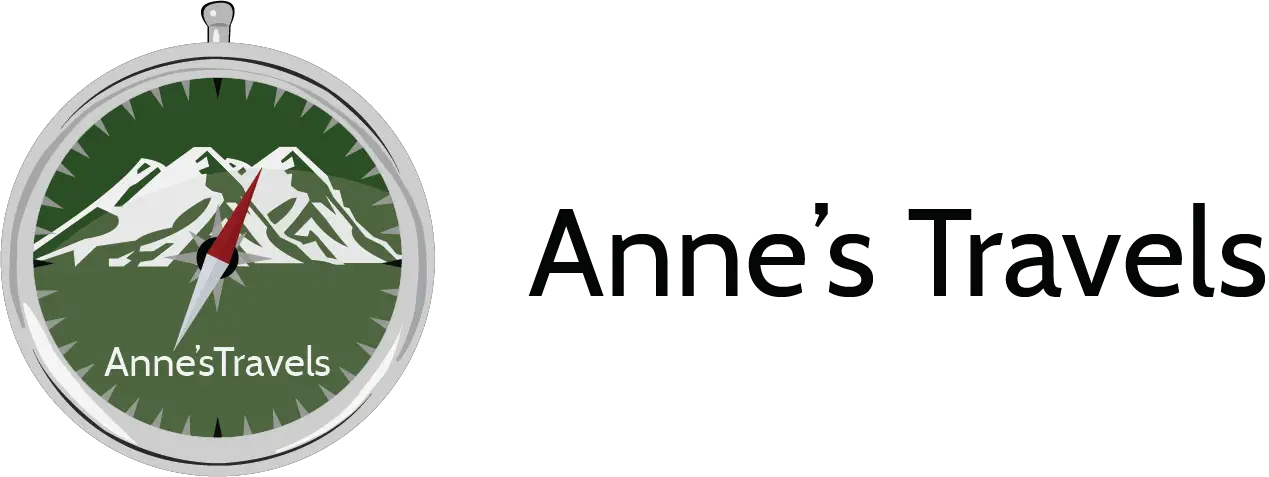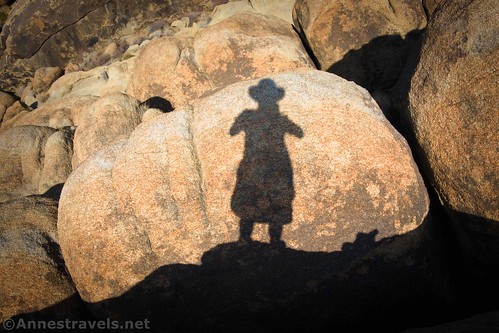I just got back from a hiking trip. I’m processing the photos (the ones here are all from my trip), but since they aren’t quite all edited yet, I thought I’d share some of the tips and tricks we used to lessen the risk of COVID-19 as we traveled. We were well aware of the risk – and given that 1) my grandmother was a microbiologist we’re all germaphobes, and 2) any common cold in a family the size of mine turns into a pandemic, it wasn’t too hard to come up with a mile-long list of things we could/should do to stay healthy – most of which we would have done regardless of COVID.
1. We kept an eye on official rules, restrictions, and guidelines – and followed them. We kept abreast of where our state would allow us to go, current closures (parks and otherwise), and so on and so forth. This was a good thing – the guidelines/laws dramatically changed while we were on the road. One member of my group was legally bound by his company to stay out of certain states that had higher numbers of COVID cases. So we planned our trip around that. We also followed in-store and in-restroom guidelines for social distancing.
In general, if there were state or local regulations, they were posted on the door to supermarkets and other stores. Most rest areas had “you must wear a mask to enter” signs on the doors; some gas stations also requested masks. The restrooms in Death Valley had signs about the county mask regulations.
Almost all of the trails and roads were open. All of the visitor centers were closed, so no park movies and we had limited access to information. There were no ranger-led hikes or ranger programs, so areas like the Fiery Furnace in Arches (which requires a tour) were closed. There were also a few administrative things that were currently unavailable – for example, overnight permits for the White Rim Road could only be secured online instead of at the visitor center like would normally be possible. A group of rangers came up Echo Canyon one night looking for someone or something, so I’m guessing SAR was available (though you’d never have known it from the lack of park ranger presence in every park I visited!) I was pleasantly surprised at the number of restrooms that were open – that’d had me worried before we left!

2. We social distanced. Actually, we’ve been practicing social distancing for years… especially if someone across the parking lot was coughing. But this was the first time we’d walk 6-10ft. off of the trail to avoid another hiker (they’d be doing it if we didn’t), wait to enter or exit a restroom until there was no one around, and turn around to go a different direction if we saw someone coming. It felt a little bit weird sometimes. I happen to like people. But the good news was that none of them seemed to mind or to find our behavior (or their own!) as antisocial.
The visitor centers were closed, but the rangers at Death Valley were there to help. They’d set up two lines, both of which had markings for social distancing: One for paying your entrance fee (a window open to a ranger at a cash register) and another for getting information (a ranger behind a couple of tables so you couldn’t get too close). It worked quite well – various rangers used laser pointers or long dowels to point stuff out on our maps. Still, I’ve never seen so few rangers out and about in national parks.
3. We used hand sanitizer. Every person in the group had hand sanitizer on them at all times (I liked these little bottles and others liked the bigger bottles
). Touch a rock? Wash your hands. Want to touch your face? Wash your hands. About to eat? Wash your hands. Use the restroom and wash your hands? Wash them again once you’re out of the building. You get the idea.
And for once, every primitive toilet I used had plenty of hand sanitizer. (Maybe that’s one of the very few benefits of COVID-19!) I’d often use that, exit, and then use my own. Paranoia? Maybe.
4. We wore masks. Depending on which side of the mask-war you’re on, that’s a no-brainer or a “why?” But we figured it couldn’t hurt; besides, most places required it. (One member of my group has worked extensively in Japan, where everyone who is sick wears a mask.) Every person in our group had a mask with them at all times (usually around their neck) so they could put it on at a moment’s notice. Sometimes that meant when going into the restroom; other times it was when a hiker was coming up the trail toward us.
Most public places had signs about “masks required.” One Walmart even had a greeter in a mask with a pair of salad tongs and a box of masks, handing them out to people as they entered if they’d forgotten to bring a mask. I call that creative! On the trail, it was a wide variety of handmade masks, store-bought masks, bandanas, and things that were never made to be a mask but worked in the situation (hats, hoodies, t-shirts, etc.) But in general, other than social distancing, most people didn’t seem too worried about COVID on the trail.
5. We touched as little as possible. We brought along disposable gloves for things like pumping gas and/or shopping. Going into rest area restrooms (you have to do something!), we’d often carry a small piece of paper towel with us. That was for opening doors, locking the stalls, turning on the water in the sink, getting soap, and whatever else we had to touch. Still, I got pretty good at doing the high-kick to push the handicap door opener button…
One of the things I found very interesting was the number of gas pumps with the ability to pay from your phone (that’s not a thing yet where I come from). Swipe the QR code or whatever the app uses to interface with the pump, and you’re good to go using Apple Pay or Google Wallet or the gas station app. It’s one way to not pass COVID germs!
6. We kept out of civilization. As much as possible, we avoided trails and places we knew would be crowded. We did our best to give everyone and anyone a wide berth on the trail – hoping that they didn’t see us as being especially anti-social (but usually they were doing the same thing!) We also avoided stores, rest areas, and gas stations as much as possible, and we never ate out.
The complete lack of tour busses was a very nice surprise. Places that usually are overrun were peaceful and quiet (I saw less than three dozen people on the entire Windows Loop in Arches in the afternoon – that harkens back into the 1990s!) But the visitation still ebbed and flowed – people told us that two weeks earlier Moab was overrun. And our first week in Death Valley was very quiet, but by the end of the second week, we were having a lot more trouble finding places to camp. Basically, if we found a place to be crowded, we didn’t come back.

7. We made all of our own food. That’s pretty typical for us, anyway. But this trip we were especially careful to bring as much as possible with us so we didn’t have to go to the store except for ice, milk, and bread. We’d eat cold cereal for breakfast, a variety of pre-packaged snacks and peanut butter sandwiches for lunch, and meals cooked on our single-burner propane stoves for supper. Ta-da.
Most of the restaurants I saw seemed to be 1) closed, 2) open for outdoor seating, or 3) snack bars that were open with no seating. They were also operating at what seemed to be much lower capacity than normal. Grocery stores seemed to be at normal operations, just with lines on the floor for social distancing.
8. We used tablecloths. It seems so simple, but we brought along disposable tablecloths for the picnic tables. That way, we were less likely to pick up germs (especially COVID) from someone else’s picnic.
The picnic areas thankfully weren’t too crowded. Of course, it might help that we usually were eating breakfast at 6am local time. Still, they were rarely empty, so they’d eat on one end of the row of tables and we’d eat at the other end.

9. We didn’t camp in population centers. In fact, we didn’t even camp in campgrounds. Death Valley has a great dispersed camping policy, and it was just easier (and safer) to be out in the wild a tenth of a mile (at least) from the nearest other camper. We did have to park in Walmart/rest areas on the way home… but we did our best to social distance there, too.
The Furnace Creek Campground was always full. Otherwise, most places seemed to still have space. We had to go miles up Echo Canyon one night to find a place to sleep; otherwise, the free-range camping roads usually had a spot within a couple of miles of the paved road.

10. We still managed to have fun! It’s amazing what kind of fun you can have, despite all the extra care. Maybe we had fewer conversations with other hikers, and maybe we were a bit more paranoid than usual about hand-washing. But we still got to relax, have fun, and enjoy the scenery!
Be on the lookout for a sneak peak at photos from the trip, hopefully coming out next week!







